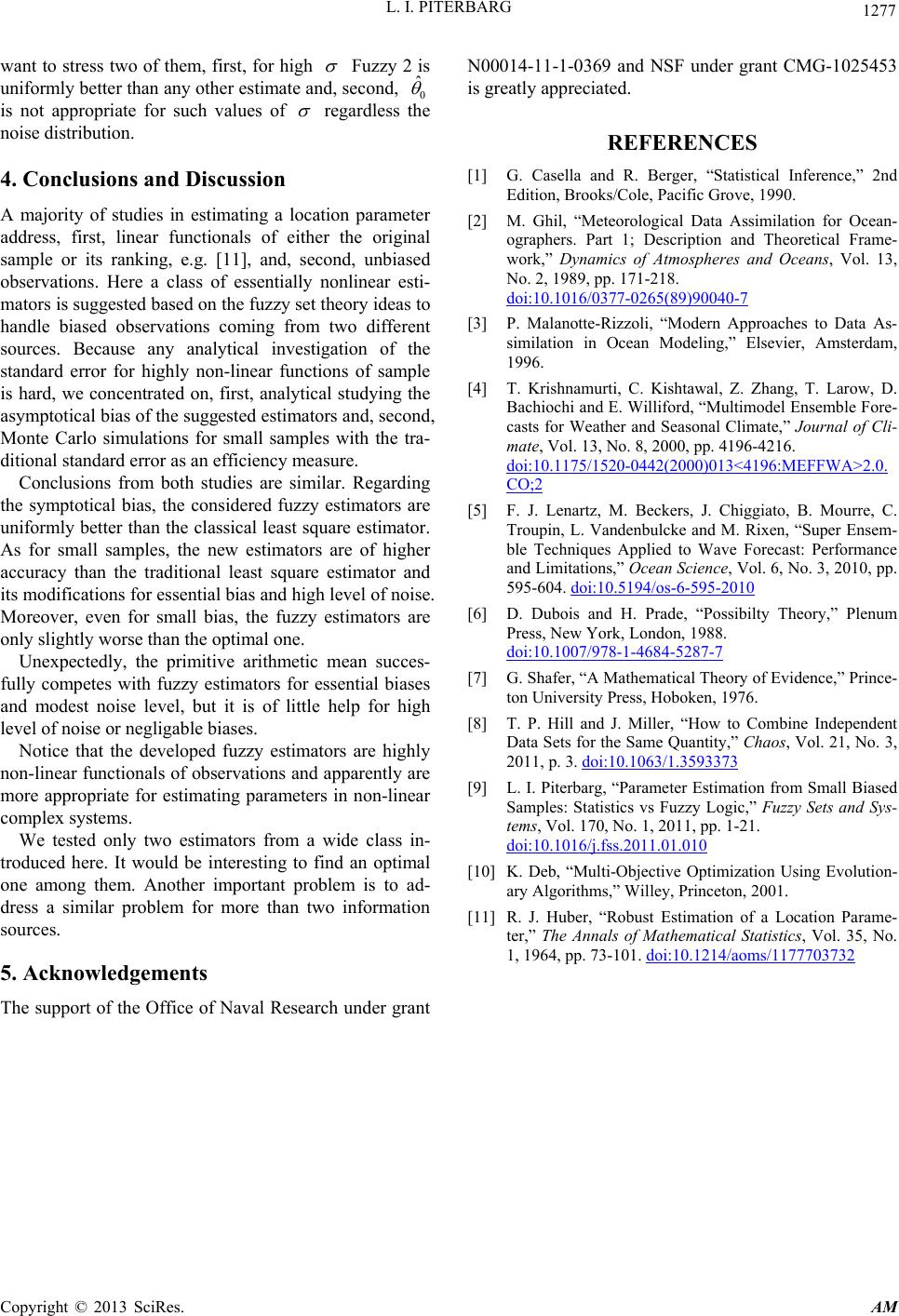
L. I. PITERBARG
Copyright © 2013 SciRes. AM
1277
want to stress two of them, first, for high
e and, second,
Fuzzy 2 is
uniformly better than any other estimat0
ˆ
is not appropriate for such values of
regardless
noise distribution.
4. Conclusions and Discussion
A majority of studies in estimating a location parameter
address, first, linear functionals of either the original
sample or its ranking, e.g. [11], and, second, unbiased
observations. Here a class of essentially nonlinear esti-
mators is suggested based on the fuzzy set theory ideas to
handle biased observations coming from two different
sources. Because any analytical investigation of the
standard error for highly non-linear functions of sample
an the classical least square estimator.
r
are estimator and
N00014-11-1-0369 and NSF under grant CMG-1025453
is greatly appreciated.
REFERENCES
[1] G. Casella and R. Berger, “Statistical Inference,” 2nd
Edition, Brooks/Cole, Pacific Grove, 1990.
[2] M. Ghil, “Meteorological Data Assimilation for Ocean-
ographers. Part 1; Description and Theoretical Frame-
work,” Dynamics of Atmospheres and Oceans, Vol. 13,
No. 2, 1989, pp. 171-218.
doi:10.1016/0377-0265(89)90040-7
the
[3] P. Malanotte-Rizzoli, “Modern Approaches to Data As-
similation in Ocean Modeling,” Elsevier, Amsterdam,
1996.
[4] T. Krishnamurti, C. Kishtawal, Z. Zhang, T. Larow, D.
casts for Weather and Seasonal Climate,” Journal of Cli-
is hard, we concentrated on, first, analytical studying the
asymptotical bias of the suggested estimators and, second,
onte Carlo simulations for small samples with the tra
Bachiochi and E. Williford, “Multimodel Ensemble Fore-
M-
ditional standard error as an efficiency measure.
Conclusions from both studies are similar. Regarding
the symptotical bias, the considered fuzzy estimators are
uniformly better th
mate, Vol. 13, No. 8, 2000, pp. 4196-4216.
doi:10.1175/1520-0442(2000)013<4196:MEFFWA>2.0.
CO;2
[5] F. J. Lenartz, M. Beckers, J. Chiggiato, B. Mourre, C.
and M. Rixen, “Super Ensem-
Wave Forecast: Performance
Troupin, L. Vandenbulcke
ble Techniques Applied to
As for small samples, the new estimators are of highe
accuracy than the traditional least squand Limitations,” Ocean Science, Vol. 6, No. 3, 2010, pp.
595-604. doi:10.5194/os-6-595-2010
[6] D. Dubois and H. Prade, “Possibilty Theory,” Plenum
Press, New York, L
its modifications for essential bias and high level of noise.
Moreover, even for small bias, the fuzzy estimators are
only slightly worse than the optimal one.
Unexpectedly, the primitive arithmetic mean succes-
fully competes with fuzzy estimators for essential biases
and modest noise level, but it is of little help for high
level of noise or negligable biases.
Notice that the developed fuzzy estimators are highly
non-linear functionals of observations and apparently are
more appropriate for estimating parameters in non-linear
complex systems.
We tested only two estimators from a wide class in-
tro
ondon, 1988.
doi:10.1007/978-1-4684-5287-7
[7] G. Shafer, “A Evidence,” Prince-
Independent
Mathematical Theory of
ton University Press, Hoboken, 1976.
[8] T. P. Hill and J. Miller, “How to Combine
Data Sets for the Same Quantity,” Chaos, Vol. 21, No. 3,
2011, p. 3. doi:10.1063/1.3593373
[9] L. I. Piterbarg, “Parameter Estimation from Small Biased
Samples: Statistics vs Fuzzy
tems, Vol. 170, No. 1, 2011, pp. 1-21
Logic,” Fuzzy Sets and Sys-
.
doi:10.1016/j.fss.2011.01.010
[10] K. Deb, “Multi-Objective Optimization Using Evolution-
ary Alg
duced here. It would be interesting to find an optimal
one among them. Another important problem is to ad-
dress a similar problem for more than two information
sources.
5. Acknowledgements
The support of the Office of Naval Research under grant
orithms,” Willey, Princeton, 2001.
[11] R. J. Huber, “Robust Estimation of a Location Parame-
ter,” The Annals of Mathematical Statistics, Vol. 35, No.
1, 1964, pp. 73-101. doi:10.1214/aoms/1177703732